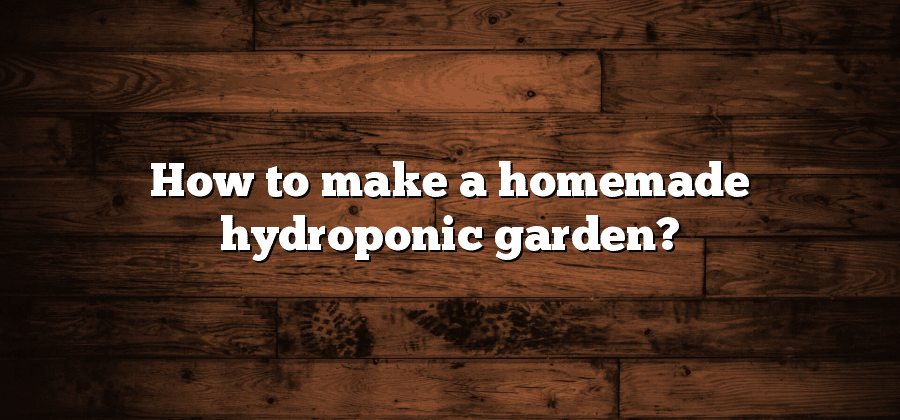Understanding the Basics of Hydroponic Gardening
Hydroponic gardening is a unique and innovative way of growing plants without the use of soil. Instead, plants are cultivated in a nutrient-rich water solution that provides all the necessary elements for their growth and development. This method has gained popularity among passionate gardeners and professionals alike, as it offers numerous benefits compared to traditional soil-based gardening.
One of the key advantages of hydroponic gardening is the ability to have complete control over the growing environment. By eliminating soil, gardeners can closely monitor and adjust factors such as pH levels, nutrient content, and water supply to ensure optimal plant growth. This level of precision allows for faster growth rates, higher yields, and healthier plants. Additionally, hydroponics eliminates the need for weeding, reducing the time and effort required to maintain the garden. With these unique advantages, it is no wonder that many gardening enthusiasts are turning to hydroponics as a viable alternative to traditional gardening methods. Read on to explore the various aspects of hydroponic gardening and unlock its full potential for your own green thumb.
Selecting the Right Location for Your Hydroponic Setup
Finding the perfect location for your hydroponic setup is crucial to the success of your garden. The first step is to consider your available space. Ideally, your hydroponic garden should be located in an area with ample natural light or access to artificial lighting. This is because plants need light to grow and thrive. Look for a spot that receives at least six to eight hours of direct sunlight per day. If this isn’t possible, you can use grow lights, but keep in mind that these will increase your energy consumption. Additionally, make sure the space is well-ventilated to provide fresh air to your plants and prevent the build-up of humidity.
Once you have determined the lighting and ventilation requirements, assess the temperature conditions of the potential location. Most plants prefer a temperature range of 65-80°F (18-27°C) for optimal growth. Avoid placing your hydroponic garden in areas that experience extreme temperature fluctuations, such as near windows or doors. These areas tend to be drafty and can lead to temperature stress for your plants. Instead, choose a location that maintains a consistent temperature throughout the day. This will provide a stable environment for your plants to flourish. By selecting the right location for your hydroponic setup, you are setting the foundation for a successful and sustainable garden.
Choosing the Appropriate Hydroponic System for Your Needs
When it comes to hydroponic gardening, choosing the appropriate system for your needs is a crucial step towards success. With a wide variety of options available, it can be overwhelming to make the right choice for your specific requirements. However, by understanding the different types of hydroponic systems and considering factors such as space, budget, and plant types, you can select a system that will suit you best.
One of the most common types of hydroponic systems is the nutrient film technique (NFT). This system involves a continuous flow of nutrient-rich water that circulates through channels, providing a thin film of nutrient solution to the plant roots. NFT systems are often favored for their simplicity and efficiency, making them an excellent choice for beginners. Alternatively, if you have limited space, a vertical hydroponic system may be a suitable option. Vertical systems allow plants to be stacked on top of each other, maximizing space utilization while still providing adequate nutrition and hydration. These systems are particularly popular for growing herbs, leafy greens, and small fruits. To explore more options and discover the perfect hydroponic system for your needs, continue reading.
Gathering Essential Equipment and Supplies
When it comes to starting your hydroponic garden, gathering the essential equipment and supplies is a crucial first step. Without the right tools and materials, it will be challenging to set up and maintain a successful hydroponic system. From nutrient solutions to grow lights, each item plays a significant role in the growth and health of your plants.
To begin, it is essential to invest in a high-quality reservoir for your nutrient solution. This container will hold the vital nutrients your plants need to thrive. Look for a sturdy and durable option that can withstand the weight of the solution and easily integrate into your hydroponic setup. Additionally, you’ll need an air pump and air stone to oxygenate the nutrient solution, promoting healthy root growth and preventing stagnant water. As you gather your equipment and supplies, it is important to prioritize quality and durability, as these factors will contribute to the long-term success of your hydroponic garden.
Intrigued by the concept of hydroponic gardening but unsure of where to start? Look no further. This article will guide you through the fundamentals of hydroponics, including how to select the right location, choose the appropriate system, prepare the growing medium, and, of course, gather the essential equipment and supplies. By the end of this comprehensive guide, you’ll have a solid understanding of the basics and be ready to embark on your hydroponic gardening journey. So, let’s dive in and discover the exciting world of hydroponics and all its possibilities.
Preparing the Growing Medium for Your Hydroponic Garden
Introduction:
Preparing the growing medium for your hydroponic garden is a crucial step in ensuring the success of your plants. The growing medium serves as the substrate, providing support and aeration to the roots, while also holding and delivering essential nutrients to the plants. In this section, we will explore the different types of growing mediums commonly used in hydroponics and discuss the factors to consider when selecting the right one for your garden.
Paragraph 1:
One of the most popular growing mediums used in hydroponic gardening is coconut coir. Made from the fibrous husk of coconut, this organic and sustainable material offers excellent water retention capabilities while allowing for adequate drainage. Additionally, coconut coir is pH neutral, which means it provides an ideal environment for nutrient absorption. Its fibrous texture promotes strong root development and prevents compacting, ensuring optimal oxygen supply to the plants. The lightweight nature of coconut coir also makes it easy to work with and allows for better control over water levels in the growing system.
Paragraph 2:
Another commonly used growing medium is perlite. Derived from volcanic rock, perlite is a lightweight and porous material that provides excellent aeration to the root zone. Its ability to retain water while allowing excess moisture to drain away makes perlite a great choice for hydroponics. Moreover, perlite is sterile, ensuring a clean and disease-free environment for your plants. In addition, it has a neutral pH, making it compatible with a wide range of plant species. Whether you choose to use coconut coir or perlite, it is crucial to properly rinse and condition the growing medium before use to remove any dust or impurities.
By understanding the different growing mediums available and their respective benefits, you can make an informed decision when preparing the growing medium for your hydroponic garden. Now that we have explored the characteristics of coconut coir and perlite, let’s dive deeper into other essential aspects of hydroponic gardening, such as selecting the right nutrients for your plants and maintaining a balanced pH level.






